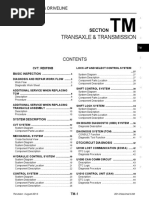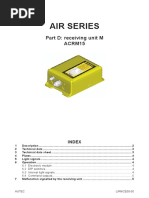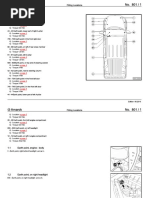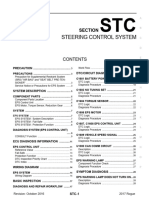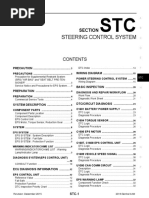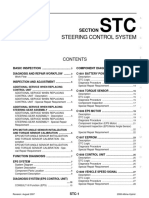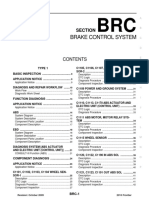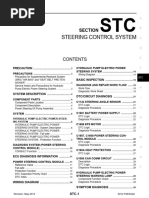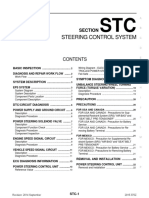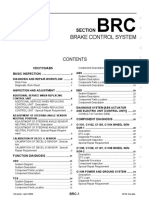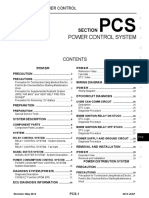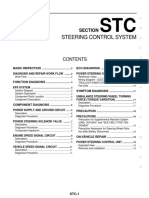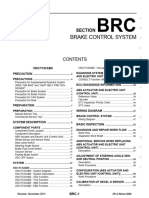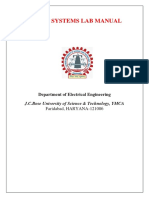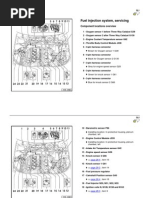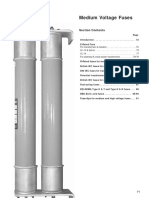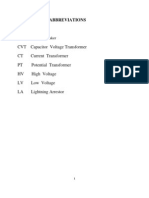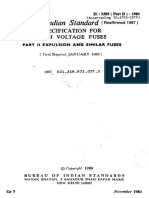Steering Control System: Section
Steering Control System: Section
Uploaded by
Erick AndradeCopyright:
Available Formats
Steering Control System: Section
Steering Control System: Section
Uploaded by
Erick AndradeOriginal Title
Copyright
Available Formats
Share this document
Did you find this document useful?
Is this content inappropriate?
Copyright:
Available Formats
Steering Control System: Section
Steering Control System: Section
Uploaded by
Erick AndradeCopyright:
Available Formats
STEERING
STC
A
B
SECTION
STEERING CONTROL SYSTEM C
E
CONTENTS
EPS Description ...............................................................15 F
DTC Logic ................................................................15
BASIC INSPECTION .................................... 3 Diagnosis Procedure ...............................................15
STC
DIAGNOSIS AND REPAIR WORKFLOW .......... 3 C1610 ENGINE STATUS SIGNAL ................... 16
Work Flow ................................................................. 3 Description ...............................................................16
DTC Logic ................................................................16
SYSTEM DESCRIPTION .............................. 5 Diagnosis Procedure ...............................................16 H
EPS SYSTEM ...................................................... 5 U1000 CAN COMM CIRCUIT ........................... 17
System Diagram ........................................................ 5 Description ...............................................................17 I
System Description ................................................... 5 DTC Logic ................................................................17
Component Parts Location ........................................ 6 Diagnosis Procedure ...............................................17
Component Description ............................................. 6
EPS WARNING LAMP ...................................... 18 J
DIAGNOSIS SYSTEM (EPS CONTROL UNIT) Description ...............................................................18
..... 7 Component Function Check ....................................18
CONSULT Function .................................................. 7 Diagnosis Procedure ...............................................18 K
DTC/CIRCUIT DIAGNOSIS .......................... 8 ECU DIAGNOSIS INFORMATION .............. 19
C1601 BATTERY POWER SUPPLY .................. 8 EPS CONTROL UNIT ....................................... 19 L
Description ................................................................ 8 Reference Value ......................................................19
DTC Logic ................................................................. 8 Wiring Diagram - ELECTRONICALLY CON-
Diagnosis Procedure ................................................. 8 TROLLED POWER STEERING SYSTEM - ............21 M
Fail-Safe ..................................................................22
C1604 TORQUE SENSOR .................................10 DTC Inspection Priority Chart ..................................23
Description .............................................................. 10 DTC Index ...............................................................23
DTC Logic ............................................................... 10 N
Diagnosis Procedure ............................................... 10 SYMPTOM DIAGNOSIS .............................. 24
C1606 EPS MOTOR ...........................................12 EPS WARNING LAMP DOES NOT TURN ON... 24 O
Description .............................................................. 12 Description ...............................................................24
DTC Logic ............................................................... 12 Diagnosis Procedure ...............................................24
Diagnosis Procedure ............................................... 12
Component Inspection ............................................ 12 EPS WARNING LAMP DOES NOT TURN P
OFF .................................................................... 25
C1607, C1608 EPS CONTROL UNIT ................14 Description ...............................................................25
Description .............................................................. 14 Diagnosis Procedure ...............................................25
DTC Logic ............................................................... 14
Diagnosis Procedure ............................................... 14 STEERING WHEEL TURNING FORCE IS
HEAVY OR LIGHT ............................................ 26
C1609 VEHICLE SPEED SIGNAL .....................15
Revision: July 2011 STC-1 2012 Versa
Description .............................................................. 26 Diagnosis Procedure ............................................... 28
Diagnosis Procedure .............................................. 26
PRECAUTION ............................................ 29
UNBALANCE STEERING WHEEL TURNING
FORCE AND RETURN BETWEEN RIGHT PRECAUTIONS ................................................. 29
AND LEFT .......................................................... 27 Precaution for Supplemental Restraint System
Description .............................................................. 27 (SRS) "AIR BAG" and "SEAT BELT PRE-TEN-
Diagnosis Procedure .............................................. 27 SIONER" ................................................................. 29
Precaution Necessary for Steering Wheel Rota-
UNBALANCE STEERING WHEEL TURNING tion After Battery Disconnect .................................. 29
FORCE (TORQUE VARIATION) ....................... 28 Service Notice or Precaution for EPS System ........ 30
Description .............................................................. 28
Revision: July 2011 STC-2 2012 Versa
DIAGNOSIS AND REPAIR WORKFLOW
< BASIC INSPECTION > [EPS]
BASIC INSPECTION A
DIAGNOSIS AND REPAIR WORKFLOW
Work Flow INFOID:0000000007328978
B
1.OBTAIN INFORMATION ABOUT SYMPTOM
Interview the customer to obtain as much information as possible about the conditions and environment under C
which the malfunction occurs.
>> GO TO 2. D
2.CHECK DTC
1. Check for DTC. E
2. If a DTC exists, perform the following operations.
- Records the DTCs.
- Erase DTCs
- Check that the root cause clarified with DTC matches to the malfunction information described by the cus- F
tomer.
3. Check also the related service information or others.
Do malfunction information or DTC exist? STC
Malfunction information and DTC exist. >>GO TO 3.
Malfunction information exists but no DTC. >>GO TO 4.
No malfunction information, but DTC exists. >>GO TO 5. H
3.REPRODUCE THE MALFUNCTION INFORMATION
Check the malfunction described by the customer on the vehicle.
Record the status of each signal when a symptom occurs with “Data Monitor” in CONSULT. I
Inspect the relation of the information and the condition when it occurs.
>> GO TO 5. J
4.CHECK THE MALFUNCTION
Check the malfunction described by the customer on the vehicle. K
Record the status of each signal when a symptom occurs with “Data Monitor” in CONSULT.
Inspect the relation of the information and the condition when it occurs.
L
>> GO TO 6.
5.PERFORM “DTC CONFIRMATION PROCEDURE”
M
Perform the “DTC conformation procedure” to the detected DTC and check that the DTC is detected again.
Refer to STC-23, "DTC Inspection Priority Chart" when multiple DTCs are detected, and then judge the order
for performing the diagnosis.
Is any DTC detected? N
YES >> GO TO 7.
NO >> Follow GI-9, "How to Follow Trouble Diagnosis" to check.
6.IDENTIFY MALFUNCTIONING SYSTEM WITH “SYMPTOM DIAGNOSIS” O
Use the “Symptom diagnosis” from the symptom inspection result in step 4. Then identify where to start per-
forming the diagnosis based on the possible causes and the symptoms. P
>> GO TO 7.
7.IDENTIFY MALFUNCTIONING PARTS WITH “COMPONENT DIAGNOSIS”
Perform the inspection with the “component diagnosis” of the applicable system.
NOTE:
The “component diagnosis” mainly consists of the check for an open circuit.
Revision: July 2011 STC-3 2012 Versa
DIAGNOSIS AND REPAIR WORKFLOW
< BASIC INSPECTION > [EPS]
The circuit check in the diagnosis procedure also requires the check for a short circuit. Refer to GI-25, "How to
Perform Efficient Diagnosis for an Electrical Incident" for details.
>> GO TO 8.
8.REPAIR OR REPLACE THE MALFUNCTIONING PARTS
1. Repair or replace the part detected as malfunctioning.
2. After repairing or replacing, reinstall/reconnect parts or connectors removed/disconnected in the “compo-
nent diagnosis”, and then erase the DTC.
>> GO TO 9.
9.FINAL CHECK
Perform the “DTC confirmation procedure” or “component Inspection” to check that the repair is correctly per-
formed. Check that malfunctions are not reproduced when obtaining the malfunction information from the cus-
tomer, referring to the symptom inspection result in step 3 or 4.
Is the check result normal?
YES >> Trouble diagnosis is completed.
NO-1 >> The DTC is reproduced. GO TO 7.
NO-2 >> The symptom is reproduced. GO TO 6.
Revision: July 2011 STC-4 2012 Versa
EPS SYSTEM
< SYSTEM DESCRIPTION > [EPS]
SYSTEM DESCRIPTION A
EPS SYSTEM
System Diagram INFOID:0000000007328979
B
STC
SGIA1701E
System Description INFOID:0000000007328980 H
• EPS control unit performs an arithmetical operation on data, such as steering wheel turning force (sensor
signal) from the torque sensor, vehicle speed signal, etc. Then it generates an optimum assist torque signal
to the EPS motor according to the driving condition. I
• EPS control unit decreases the output signal to EPS motor while extremely using the power steering func-
tion (e.g., full steering) consecutively for protecting EPS motor and EPS control unit (Overload protection
control). While activating overload protection control, the assist torque gradually decreases, and the steering J
wheel turning force becomes heavy. The normal assist torque reactivates by no steering.
• In case of an error in the electrical system, the fail-safe function stops output signals to the EPS motor. Then
the previous state is changed to the manual steering state.
K
• Self-diagnosis can be done with CONSULT.
• EPS control unit will decrease assistance under the following 2 conditions.
- Extensive steering at low speed will cause the ECU and MOTOR to heat up, once temperature reaches crit-
ical point ECU will reduce current to reduce heat up. System will recover as temperature lowers (reduced or L
no assistance).
- Holding steering on rack-end (full lock) for 1 second will cause the system to engage rack-end protection.
This reduces assistance down to 50% in order to prevent heat up. Assistance is immediately returned to M
100% when steering released or turned away from rack-end.
- Communicates the signal from each control unit via CAN communication.
Control unit Signal status N
Transmits mainly the following signals to EPS control unit via CAN communication.
ECM
Engine status signal
ABS actuator and electric unit Transmits mainly the following signals to EPS control unit via CAN communication. O
(control unit) Vehicle speed signal
• Transmits mainly the following signals to EPS control unit via CAN communication.
Combination meter Vehicle speed signal P
• EPS warning lamp signal is received from the EPS control unit via CAN communication.
Revision: July 2011 STC-5 2012 Versa
EPS SYSTEM
< SYSTEM DESCRIPTION > [EPS]
Component Parts Location INFOID:0000000007328981
SGIA1623E
Component Description INFOID:0000000007328982
Components parts Reference
EPS control unit STC-14, "Description"
EPS motor STC-12, "Description"
Torque sensor STC-10, "Description"
Reduction gear increases the assist torque provided from EPS
Reduction gear
motor with worm gears, and outputs to the column shaft.
EPS warning lamp STC-18, "Description"
Revision: July 2011 STC-6 2012 Versa
DIAGNOSIS SYSTEM (EPS CONTROL UNIT)
< SYSTEM DESCRIPTION > [EPS]
DIAGNOSIS SYSTEM (EPS CONTROL UNIT)
A
CONSULT Function INFOID:0000000007328983
FUNCTION B
CONSULT can display each diagnostic item using the diagnostic test modes shown following.
Diagnostic test mode Function C
ECU identification Steering column assembly number can be read.
Self diagnostic result Self-diagnostic results can be read and erased quickly.
CAN diag support MNTR The results of transmit/receive diagnosis of CAN communication can be read. D
Data monitor Input/Output data in the EPS control unit can be read.
ECU IDENTIFICATION E
Displays the part number stored in the control unit.
SELF-DIAG RESULTS MODE
F
Display Item List
Refer to STC-23, "DTC Index".
CAUTION:
If “CAN COMM CIRCUIT [U1000]” is displayed with other DTCs, first perform the trouble diagnosis for STC
CAN communication line.
DATA MONITOR MODE H
Display Item List
Monitor item (Unit) Remarks I
BATTERY VOLT (V) Displays the power supply voltage for EPS control unit.
TORQUE SENSOR (Nm) Displays steering wheel turning force detected by torque sensor.
J
MOTOR CURRENT (A) Displays the current value consumed by EPS motor.
MOTOR SIG (A)*1 Displays the current commanded value to EPS motor.
VEHICLE SPEED (km/h) or (MPH)*2 Vehicle speed is displayed from vehicle speed signal via CAN communication. K
WARNING LAMP (On/Off) EPS warning lamp control status is displayed.
ENGINE STATUS (Stop/Run) Engine speed is displayed from engine status signal via CAN communication.
L
*1: Almost in accordance with the value of MOTOR SIG. It is not a malfunction though these values are not accorded when steering
quickly.
*2: It is not a malfunction, though it might not be corresponding just after ignition switch in turned ON.
M
Revision: July 2011 STC-7 2012 Versa
C1601 BATTERY POWER SUPPLY
< DTC/CIRCUIT DIAGNOSIS > [EPS]
DTC/CIRCUIT DIAGNOSIS
C1601 BATTERY POWER SUPPLY
Description INFOID:0000000007328984
Power is supplied from the battery to EPS control unit.
DTC Logic INFOID:0000000007328985
DTC DETECTION LOGIC
DTC Display item Malfunction detected condition Possible cause
• Harness or connector
When a power supply voltage to the EPS control unit
• EPS control unit
C1601 BATTERY VOLT is maintained at or above 17.5 V or less than 9 V con-
• Fuse
tinuously for more than five seconds.
• Power supply system
DTC CONFIRMATION PROCEDURE
1.DTC REPRODUCTION PROCEDURE
With CONSULT
1. Turn the ignition switch OFF to ON.
2. Perform EPS control unit self-diagnosis.
Is DTC “C1601” detected?
YES >> Proceed to diagnosis procedure. Refer to STC-8, "Diagnosis Procedure".
NO >> Inspection End.
Diagnosis Procedure INFOID:0000000007328986
1.CHECK EPS CONTROL UNIT GROUND CIRCUIT
1. Turn ignition switch OFF.
2. Disconnect EPS control unit harness connector.
3. Check continuity between EPS control unit harness connector
terminal and ground.
EPS control unit
— Continuity
Connector Terminal
M54 18 Ground Existed
Is the inspection result normal?
YES >> GO TO 2.
NO >> Repair open circuit or short to ground or short to power
in harness or connectors. AWGIA0180ZZ
2.CHECK EPS CONTROL UNIT POWER SUPPLY CIRCUIT
1. Connect EPS control unit harness connector.
2. Check voltage between EPS control unit harness connector
M53 (A), M54 (B) terminals and ground.
EPS control unit
— Voltage
Connector Terminal
M53 (A) 10 Approx. 0 V
Ground
M54 (B) 17 Battery voltage
3. Turn ignition switch ON.
CAUTION:
AWGIA0181ZZ
Never start the engine.
Revision: July 2011 STC-8 2012 Versa
C1601 BATTERY POWER SUPPLY
< DTC/CIRCUIT DIAGNOSIS > [EPS]
4. Check voltage between EPS control unit harness connector
M53 (A), M54 (B) terminals and ground. A
EPS control unit
— Voltage
Connector Terminal B
M53 (A) 10
Ground Battery voltage
M54 (B) 17
C
Is the inspection result normal?
YES >> GO TO 3. AWGIA0182ZZ
NO >> Check the following. If any items are damaged, repair D
or replace damaged parts.
• 10A fuse (#2) open
- Harness for short between 10A fuse (#2) and power steering control unit harness connector No.
10 terminal. E
• 60A fusible link (M) open
- Harness for short between 60A fusible link (M) and power steering control unit harness connec-
tor No. 10 terminal. F
• Harness for open between ignition switch and power steering control unit harness connector
No. 17 terminal.
• Harness for open between battery and power steering control unit harness connector No. 17 ter-
minal. STC
• Battery or ignition switch.
3.CHECK BATTERY VOLTAGE SIGNAL (1) H
With CONSULT
1. Start the engine.
CAUTION: I
Stop the vehicle.
2. Select “EPS”, “DATA MONITOR” and “MOTOR VOLT”, and perform the battery voltage inspection.
J
Monitor item Condition Display value
MOTOR VOLT Engine running Battery voltage
Is the inspection result normal? K
YES >> GO TO 4.
NO >> Replace EPS control unit. Refer to PS-10, "Removal and Installation".
4.CHECK MOTOR VOLTAGE SIGNAL (2) L
With CONSULT
Select “MOTOR VOLT” in “DATA MONITOR” of the EPS control unit. Check motor voltage with the steering
M
wheel fully turned leftward or rightward.
Is the value in “DATA MONITOR”“between 9 V and 17.5 V”?
YES >> Check pin terminal and connection of each harness connector for damage or loose connection.
N
NO >> Check battery power supply and ignition power supply. Refer to STC-21, "Wiring Diagram - ELEC-
TRONICALLY CONTROLLED POWER STEERING SYSTEM -".
Revision: July 2011 STC-9 2012 Versa
C1604 TORQUE SENSOR
< DTC/CIRCUIT DIAGNOSIS > [EPS]
C1604 TORQUE SENSOR
Description INFOID:0000000007328987
Torque sensor detects the steering torque, and transmit the signal to EPS control unit.
DTC Logic INFOID:0000000007328988
DTC DETECTION LOGIC
DTC Display item Malfunction detected condition Possible cause
• Harness or connector
C1604 TORQUE SENSOR When torque sensor output signal is malfunctioning. • Torque sensor
• EPS control unit
DTC CONFIRMATION PROCEDURE
1.DTC REPRODUCTION PROCEDURE
With CONSULT
1. Turn the ignition switch OFF to ON.
2. Perform EPS control unit self-diagnosis.
Is DTC “C1604” detected?
YES >> Proceed to diagnosis procedure. Refer to STC-10, "Diagnosis Procedure".
NO >> Inspection End.
Diagnosis Procedure INFOID:0000000007328989
1.CHECK TORQUE SENSOR POWER SUPPLY CIRCUIT
1. Turn ignition switch OFF to ON.
CAUTION:
Never start the engine.
2. Check voltage between EPS control unit harness connector terminals and ground.
CAUTION:
Steering wheel is neutral position. (There is no steering
force.)
EPS control unit
— Voltage
Connector Terminal
M53 5 Ground Approx. 5 V
Is the inspection result normal?
YES >> GO TO 2.
NO >> Perform the trouble diagnosis for battery power supply
circuit. Refer to STC-8, "Diagnosis Procedure". AWGIA0183ZZ
2.CHECK TORQUE SENSOR GROUND CIRCUIT
1. Turn ignition switch OFF.
2. Check continuity between EPS control unit harness connector terminal and ground.
CAUTION:
Revision: July 2011 STC-10 2012 Versa
C1604 TORQUE SENSOR
< DTC/CIRCUIT DIAGNOSIS > [EPS]
Steering wheel is neutral position. (There is no steering
force.) A
EPS control unit
— Continuity
Connector Terminal B
M53 7 Ground Yes
Is the inspection result normal? C
YES >> GO TO 3.
NO >> Repair open circuit or short to ground or short to power
in harness or connectors. AWGIA0184ZZ
D
3.CHECK TORQUE SENSOR SIGNAL
1. Turn ignition switch ON.
2. Check voltage between EPS control unit harness connector terminal and ground. E
CAUTION:
Steering wheel is neutral position. (There is no steering
force.)
F
EPS control unit
— Voltage
Connector Terminal STC
4
M53 Ground Approx. 2.5V
6
H
3. Start the engine.
AWGIA0185ZZ
4.
I
Check voltage between torque sensor harness connector termi-
nal and ground while turning the steering wheel.
J
Torque sensor
— Voltage
Connector Terminal
1 1.6 V – 3.4 V K
M63 Ground (The value is changed
3 according to steering
L
left or right)
AWGIA0187ZZ
Is the inspection result normal?
YES >> GO TO 4. M
NO >> Torque sensor is malfunction. Replace steering column assembly. Refer to PS-10, "Removal and
Installation".
4.CHECK CONNECTOR N
1. Turn ignition switch OFF.
2. Disconnect torque sensor harness connector.
3. Check terminal for deformation, disconnection, looseness, and so on. If any malfunction is found, repair or O
replace terminal.
Is the inspection result normal?
YES >> Replace EPS control unit. Refer to PS-10, "Removal and Installation". P
NO >> Repair or replace error-detected parts.
Revision: July 2011 STC-11 2012 Versa
C1606 EPS MOTOR
< DTC/CIRCUIT DIAGNOSIS > [EPS]
C1606 EPS MOTOR
Description INFOID:0000000007328990
EPS motor provides the assist torque by the control signal from EPS control unit.
DTC Logic INFOID:0000000007328991
DTC DETECTION LOGIC
DTC Display item Malfunction detected condition Possible cause
• Harness or connector
When the motor driver malfunction of EPS control
C1606 EPS MOTOR • EPS motor
unit or EPS motor malfunction is detected.
• EPS control unit
DTC CONFIRMATION PROCEDURE
1.DTC REPRODUCTION PROCEDURE
With CONSULT
1. Turn the ignition switch OFF to ON.
2. Perform EPS control unit self-diagnosis.
Is DTC “C1606” detected?
YES >> Proceed to diagnosis procedure. Refer to STC-12, "Diagnosis Procedure".
NO >> Inspection End.
Diagnosis Procedure INFOID:0000000007328992
1.CHECK EPS MOTOR
Check the EPS motor. Refer to STC-12, "Component Inspection".
Is the inspection result normal?
YES >> GO TO 2.
NO >> EPS motor is malfunction. Replace steering column assembly. Refer to PS-10, "Removal and
Installation".
2.CHECK CONNECTOR
1. Turn ignition switch OFF.
2. Disconnect EPS motor harness connector.
3. Check terminal for deformation, disconnection, looseness, and so on. If any malfunction is found, repair or
replace terminal.
Is the inspection result normal?
YES >> Replace EPS control unit. Refer to PS-10, "Removal and Installation".
NO >> Repair or replace error-detected parts.
Component Inspection INFOID:0000000007328993
1.CHECK EPS MOTOR
1. Turn the ignition switch OFF.
2. Disconnect EPS motor harness connector.
Revision: July 2011 STC-12 2012 Versa
C1606 EPS MOTOR
< DTC/CIRCUIT DIAGNOSIS > [EPS]
3. Check resistance between EPS motor connector terminals.
A
EPS motor
Resistance (Approx.)
Terminal
B
19 20 0.1 Ω or less
Is the inspection result normal?
YES >> Inspection End C
NO >> EPS motor is malfunction. Replace steering column
assembly. Refer to PS-10, "Removal and Installation".
AWGIA0186ZZ
STC
Revision: July 2011 STC-13 2012 Versa
C1607, C1608 EPS CONTROL UNIT
< DTC/CIRCUIT DIAGNOSIS > [EPS]
C1607, C1608 EPS CONTROL UNIT
Description INFOID:0000000007328994
EPS control unit performs an arithmetical operation on data, such as steering wheel turning force (sensor sig-
nal) from the torque sensor, vehicle speed signal, etc. Then it generates an optimum assist torque signal to the
EPS motor according to the driving condition.
DTC Logic INFOID:0000000007328995
DTC DETECTION LOGIC
DTC Display item Malfunction detected condition Possible cause
When the memory (EEPROM) system malfunction is
C1607 EEPROM
detected in EPS control unit.
EPS control unit
When the internal malfunction is detected in EPS
C1608 CONTROL UNIT
control unit.
DTC CONFIRMATION PROCEDURE
1.DTC REPRODUCTION PROCEDURE
With CONSULT
1. Turn the ignition switch OFF to ON.
2. Perform EPS control unit self-diagnosis.
Is DTC “C1607” or “C1608” detected?
YES >> Proceed to diagnosis procedure. Refer to STC-14, "Diagnosis Procedure".
NO >> Inspection End.
Diagnosis Procedure INFOID:0000000007328996
1.PERFORM SELF-DIAGNOSIS
With CONSULT
1. Turn the ignition switch OFF to ON.
2. Erase EPS control unit self-diagnostic results.
3. Perform EPS control unit self-diagnosis.
Is DTC “C1607” or “C1608” detected?
YES >> Replace EPS control unit. Refer to PS-10, "Removal and Installation".
NO >> Check EPS control unit pin terminals for damage or loose connection with harness connector. If
any item are damaged, repair or replace error-detected parts.
Revision: July 2011 STC-14 2012 Versa
C1609 VEHICLE SPEED SIGNAL
< DTC/CIRCUIT DIAGNOSIS > [EPS]
C1609 VEHICLE SPEED SIGNAL
A
Description INFOID:0000000007328997
EPS control unit receives the vehicle speed signal from ABS actuator and electric unit (control unit) via CAN B
communication line.
DTC Logic INFOID:0000000007328998
C
DTC DETECTION LOGIC
DTC Display item Malfunction detected condition Possible cause D
• Malfunction is detected in vehicle speed signal that • Harness or connector
is output from ABS actuator and electric unit (con- • CAN communication line
C1609 CAN VHCL SPEED trol unit) via CAN communication. • EPS control unit E
• ABS actuator and electric unit (control unit) input • ABS malfunction
signal error is detected. - Vehicle speed signal error
DTC CONFIRMATION PROCEDURE F
1.DTC REPRODUCTION PROCEDURE
With CONSULT STC
1. Turn the ignition switch OFF to ON.
2. Perform EPS control unit self-diagnosis.
Is DTC “C1609” detected? H
YES >> Proceed to diagnosis procedure. Refer to STC-15, "Diagnosis Procedure".
NO >> Inspection End.
Diagnosis Procedure INFOID:0000000007328999 I
1.PERFORM ABS ACTUATOR AND ELECTRIC UNIT (CONTROL UNIT) SELF-DIAGNOSIS
With CONSULT J
1. Turn the ignition switch OFF to ON.
2. Perform ABS actuator and electrical unit (control unit) self-diagnosis. Refer to BRC-25, "CONSULT Func-
tion (ABS)". K
Is any DTC detected?
YES >> Check the DTC. Refer to BRC-25, "CONSULT Function (ABS)".
NO >> GO TO 2. L
2.PERFORM SELF-DIAGNOSIS
With CONSULT M
Perform EPS control unit self-diagnosis.
Is DTC “C1609” detected?
YES >> Replace EPS control unit. Refer to PS-10, "Removal and Installation". N
NO >> Check EPS control unit pin terminals for damage or loose connection with harness connector. If
any item are damaged, repair or replace error-detected parts.
O
Revision: July 2011 STC-15 2012 Versa
C1610 ENGINE STATUS SIGNAL
< DTC/CIRCUIT DIAGNOSIS > [EPS]
C1610 ENGINE STATUS SIGNAL
Description INFOID:0000000007329000
EPS control unit receives the engine status signal from ECM via CAN communication line.
DTC Logic INFOID:0000000007329001
DTC DETECTION LOGIC
DTC Display item Malfunction detected condition Possible cause
• Harness or connector
• Malfunction is detected in engine status signal
• CAN communication line
that is output from ECM via CAN communica-
C1610 CAN ENG RPM • EPS control unit
tion.
• ECM
• ECM input signal error is detected.
- Engine status signal error
DTC CONFIRMATION PROCEDURE
1.DTC REPRODUCTION PROCEDURE
With CONSULT
1. Turn the ignition switch OFF to ON.
2. Perform EPS control unit self-diagnosis.
Is DTC “C1610” detected?
YES >> Proceed to diagnosis procedure. Refer to STC-16, "Diagnosis Procedure".
NO >> Inspection End.
Diagnosis Procedure INFOID:0000000007329002
1.PERFORM ECM SELF-DIAGNOSIS
With CONSULT
1. Turn the ignition switch OFF to ON.
2. Perform ECM self-diagnosis. Refer to EC-119, "CONSULT Function (ENGINE)".
Is any DTC detected?
YES >> Check the DTC. Refer to EC-9, "U0101-U1001".
NO >> GO TO 2.
2.PERFORM SELF-DIAGNOSIS
With CONSULT
Perform EPS control unit self-diagnosis.
Is DTC “C1610” detected?
YES >> Replace EPS control unit. Refer to PS-10, "Removal and Installation".
NO >> Check EPS control unit pin terminals for damage or loose connection with harness connector. If
any item are damaged, repair or replace error-detected parts.
Revision: July 2011 STC-16 2012 Versa
U1000 CAN COMM CIRCUIT
< DTC/CIRCUIT DIAGNOSIS > [EPS]
U1000 CAN COMM CIRCUIT
A
Description INFOID:0000000007329003
CAN (Controller Area Network) is a serial communication line for real time application. It is an on-vehicle mul- B
tiplex communication line with high data communication speed and excellent error detection ability. Many elec-
tronic control units are equipped onto a vehicle, and each control unit shares information and links with other
control units during operation (not independent). In CAN communication, control units are connected with 2
communication lines (CAN-H line, CAN-L line) allowing a high rate of information transmission with less wiring. C
Each control unit communicate data but selectively reads required data only.
DTC Logic INFOID:0000000007329004
D
DTC DETECTION LOGIC
E
DTC Display item Malfunction detected condition Possible cause
EPS control unit is not transmitting/re-
• CAN communication error
U1000 CAN COMM CIRCUIT ceiving CAN communication signal for 2
• EPS control unit F
seconds or more.
DTC CONFIRMATION PROCEDURE
1.DTC REPRODUCTION PROCEDURE STC
With CONSULT
1. Turn the ignition switch OFF to ON.
H
2. Perform EPS control unit self-diagnosis.
Is DTC “U1000” detected?
YES >> Proceed to diagnosis procedure. Refer to STC-17, "Diagnosis Procedure".
I
NO >> Inspection End
Diagnosis Procedure INFOID:0000000007329005
J
1.PERFORM SELF-DIAGNOSIS
With CONSULT
Perform EPS control unit self-diagnosis. K
Is DTC “U1000” detected?
YES >> CAN specification chart. Refer to LAN-14, "Trouble Diagnosis Flow Chart".
NO >> Inspection End. L
Revision: July 2011 STC-17 2012 Versa
EPS WARNING LAMP
< DTC/CIRCUIT DIAGNOSIS > [EPS]
EPS WARNING LAMP
Description INFOID:0000000007329006
• Turn ON when there is a malfunction in EPS system. If indicates that fail-safe mode is engaged and enters a
manual steering state (Control turning force steering wheel becomes heavy).
• Also turns ON when ignition switch is turned ON, for purpose of lamp check. Turns OFF after the engine
starts, if system is normal.
EPS WARNING LAMP INDICATION
Condition EPS warning lamp
Ignition switch ON. (Lamp check) ON
Engine running. OFF
EPS system malfunction [Other diagnostic item] ON
CAUTION:
EPS warning lamp also turns ON due to data reception error, CAN communication error etc.
Component Function Check INFOID:0000000007329007
1.CHECK THE ILLUMINATION OF THE EPS WARNING LAMP
Check that the EPS warning lamp turns ON when ignition switch turns ON. Then, EPS warning lamp turns
OFF after the engine is started.
Is the inspection result normal?
YES >> Inspection End
NO >> Perform trouble diagnosis. Refer to STC-18, "Diagnosis Procedure".
Diagnosis Procedure INFOID:0000000007329008
1.PERFORM SELF-DIAGNOSIS
With CONSULT
1. Turn the ignition switch OFF to ON.
2. Perform EPS control unit self-diagnosis.
Is any DTC detected?
YES >> Check the DTC. Refer to STC-23, "DTC Index".
NO >> GO TO 2.
2.CHECK EPS WARNING LAMP SIGNAL
With CONSULT
1. Turn the ignition switch ON.
CAUTION:
Never start the engine.
2. On “DATA MONITOR”, select “WARNING LAMP”.
3. Check that the EPS warning lamp is turned ON.
EPS warning lamp ON: On
4. Start the engine.
CAUTION:
Stop the vehicle.
5. Check that the EPS warning lamp is turned OFF.
EPS warning lamp OFF: Off
Is the inspection result normal?
YES >> Perform the trouble diagnosis for combination meter power supply circuit. Refer to DI-15, "Power
Supply and Ground Circuit Inspection".
NO >> Replace the EPS control unit. Refer to PS-10, "Removal and Installation".
Revision: July 2011 STC-18 2012 Versa
EPS CONTROL UNIT
< ECU DIAGNOSIS INFORMATION > [EPS]
ECU DIAGNOSIS INFORMATION A
EPS CONTROL UNIT
Reference Value INFOID:0000000007329009
B
VALUES ON THE DIAGNOSIS TOOL
CAUTION: C
The output signal indicates the EPS control unit calculation data. The normal values will be displayed
even in the event that the output circuit (harness) is open.
Data monitor D
Monitor item Display content
Condition Display value
Power supply voltage for
MOTOR VOL Ignition switch: ON Battery voltage E
EPS control unit
Steering wheel: Not steering
Approx. 0 Nm
(There is no steering force)
Steering wheel turning F
TORQUE SENSOR Engine running
force Steering wheel: Right turn Positive value (Nm)
Steering wheel: Left turn Negative value (Nm)
Steering wheel: Not steering STC
Approx. 0 A
Consumption current of (There is no steering force)
MOTOR CURRENT Engine running
EPS motor Steering wheel: Right or left Displays consumption cur-
turn rent of EPS motor (A)*1 H
Steering wheel: Not steering
Approx. 0 A
(There is no steering force)
Command current to
MOTOR SIG Engine running
EPS motor Steering wheel: Right turn Negative value (A) I
Steering wheel: Left turn Positive value (A)
Displays overload sta-
DERATING STAT Engine running Off J
tus.
Vehicle stopped 0 km/h (0 mph)
VEHICLE SPEED Vehicle speed Approximately equal to the
While driving indication on speedometer K
*2
(inside of ±10%)
EPS warning lamp con- EPS warning lamp: ON On
WARNING LAMP
dition
L
EPS warning lamp: OFF Off
Engine not running Stop
ENGINE STATUS Engine status
Engine running Run M
*1: Almost in accordance with the value of MOTOR SIG. It is not a malfunction though these values are not accorded when steering
quickly.
*2: It is not a malfunction, though it might not be corresponding just after ignition switch in turned ON. N
TERMINAL LAYOUT
O
SGIA1624E
PHYSICAL VALUES
Revision: July 2011 STC-19 2012 Versa
EPS CONTROL UNIT
< ECU DIAGNOSIS INFORMATION > [EPS]
Terminal No.
Description Value
(Wire Color) Condition
(Approx.)
+ − Signal name Input/Output
Steering wheel: Not
Ignition switch: ON steering (There is no 2.5 V
steering force)
4
Ground Torque sensor sub Input 1.6 V – 3.4 V
(V)
Steering wheel: steer- (The value is changed
Engine running
ing according to steering
left or right)
5 Torque sensor power
Ground Output Ignition switch: ON 5V
(BR) supply
Steering wheel: Not
Ignition switch: ON steering (There is no 2.5 V
steering force)
6
Ground Torque sensor main Input 1.6 V – 3.4 V
(G)
Steering wheel: steer- (The value is changed
Engine running
ing according to steering
left or right)
7
Ground Torque sensor ground — Always 0V
(R)
9
Ground CAN-H Input/Output — —
(L)
10 Ignition switch: ON Battery voltage
Ground Ignition power supply Input
(O) Ignition switch: OFF 0V
16
Ground CAN-L Input/Output — —
(P)
17
Ground Battery power supply Input Always Battery voltage
(R)
18
Ground Ground — Always 0V
(B)
19 — Motor — — —
20 — Motor — — —
Revision: July 2011 STC-20 2012 Versa
EPS CONTROL UNIT
< ECU DIAGNOSIS INFORMATION > [EPS]
Wiring Diagram - ELECTRONICALLY CONTROLLED POWER STEERING SYSTEM -
INFOID:0000000007329010 A
STC
ABGWA0024GB
Revision: July 2011 STC-21 2012 Versa
EPS CONTROL UNIT
< ECU DIAGNOSIS INFORMATION > [EPS]
AAGWA0010GB
Fail-Safe INFOID:0000000007329011
• If any malfunction occurs in the system, and control unit detects the malfunction, EPS warning lamp on com-
bination meter turns ON to indicate system malfunction.
• When EPS warning lamp is ON, enters into a manual steering state. (Control turning force steering wheel
becomes heavy.)
Revision: July 2011 STC-22 2012 Versa
EPS CONTROL UNIT
< ECU DIAGNOSIS INFORMATION > [EPS]
DTC Inspection Priority Chart INFOID:0000000007329012
A
When multiple DTCs are detected simultaneously, check one by one depending on the following priority list.
Priority Priority order item (DTC) B
1 U1000 CAN COMM CIRCUIT
2 C1601 BATTERY POWER SUPPLY
3 Other than the above C
DTC Index INFOID:0000000007329013
DTC Items (CONSULT screen terms) Reference
C1601 BATTERY VOLT STC-8, "DTC Logic" E
C1604 TORQUE SENSOR STC-10, "DTC Logic"
C1606 EPS MOTOR STC-12, "DTC Logic"
C1607 EEPROM STC-14, "DTC Logic" F
C1608 CONTROL UNIT STC-14, "DTC Logic"
C1609 CAN VHCL SPEED STC-15, "DTC Logic" STC
C1610 CAN ENG RPM STC-16, "DTC Logic"
U1000 CAN COMM CIRCUIT STC-17, "DTC Logic"
H
Revision: July 2011 STC-23 2012 Versa
EPS WARNING LAMP DOES NOT TURN ON
< SYMPTOM DIAGNOSIS > [EPS]
SYMPTOM DIAGNOSIS
EPS WARNING LAMP DOES NOT TURN ON
Description INFOID:0000000007329014
EPS warning lamp does not turn ON when turning ignition switch ON from OFF. (Check the illumination of the
EPS warning lamp.)
Diagnosis Procedure INFOID:0000000007329015
1.CHECK EPS WARNING LAMP
Perform the trouble diagnosis of EPS warning Lamp. Refer to STC-18, "Diagnosis Procedure".
Is the inspection result normal?
YES >> Check that there is no malfunction in each harness connector pin terminal or disconnection.
NO >> Repair or replace the specific malfunctioning part.
Revision: July 2011 STC-24 2012 Versa
EPS WARNING LAMP DOES NOT TURN OFF
< SYMPTOM DIAGNOSIS > [EPS]
EPS WARNING LAMP DOES NOT TURN OFF
A
Description INFOID:0000000007329016
EPS warning lamp does not turn OFF several seconds after engine started. B
Diagnosis Procedure INFOID:0000000007329017
1.PERFORM SELF-DIAGNOSIS C
With CONSULT
1. Turn the ignition switch OFF to ON.
2. Perform EPS control unit self-diagnosis. D
Is any DTC detected?
YES >> Check the DTC. Refer to STC-23, "DTC Index".
NO >> GO TO 2. E
2.CHECK EPS WARNING LAMP
Perform the trouble diagnosis of EPS warning Lamp. Refer to STC-18, "Diagnosis Procedure". F
Is the inspection result normal?
YES >> GO TO 3.
NO >> Repair or replace the specific malfunctioning part. STC
3.CHECK EPS CONTROL UNIT POWER SUPPLY AND GROUND CIRCUIT
Perform the trouble diagnosis of EPS control unit power supply and ground. Refer to STC-8, "Diagnosis Pro-
H
cedure".
Is the inspection result normal?
YES >> Check that there is no malfunction in each harness connector pin terminal or disconnection. I
NO >> Repair or replace the specific malfunctioning part.
Revision: July 2011 STC-25 2012 Versa
STEERING WHEEL TURNING FORCE IS HEAVY OR LIGHT
< SYMPTOM DIAGNOSIS > [EPS]
STEERING WHEEL TURNING FORCE IS HEAVY OR LIGHT
Description INFOID:0000000007329018
Steering wheel turning force is heavy or light.
Diagnosis Procedure INFOID:0000000007329019
1.CHECK THE ILLUMINATION OF THE EPS WARNING LAMP
Check that the EPS warning lamp turns ON when ignition switch turns ON. Then, EPS warning lamp turns
OFF after the engine is started.
Is the inspection result normal?
YES >> GO TO 4.
NO >> GO TO 2.
2.PERFORM SELF-DIAGNOSIS
With CONSULT
1. Turn the ignition switch OFF to ON.
2. Perform EPS control unit self-diagnosis.
Is any DTC detected?
YES >> Check the DTC. Refer to STC-23, "DTC Index".
NO >> GO TO 3.
3.CHECK EPS CONTROL UNIT SIGNAL
With CONSULT
1. Start the engine.
CAUTION:
Stop the vehicle.
2. Turn steering wheel from full left stop to full right stop.
3. Select “TORQUE SENSOR” of “DATA MONITOR” for EPS control unit.
Monitor item Condition Display value
Steering wheel: Not steer-
ing (There is no steering Approx. 0 Nm
force)
TORQUE SENSOR
Steering wheel: Right turn Positive value (Nm)
Steering wheel: Left turn Negative value (Nm)
Is the inspection result normal?
YES >> GO TO 5.
NO >> GO TO 4.
4.CHECK EPS MOTOR
Perform the trouble diagnosis of EPS motor. Refer to STC-12, "Diagnosis Procedure".
Is the inspection result normal?
YES >> GO TO 5.
NO >> Repair or replace the specific malfunctioning part.
5.CHECK STEERING WHEEL TURNING FORCE
Check the steering wheel turning force. Refer to PS-6, "On-Vehicle Inspection and Service".
Is the inspection result normal?
YES >> Inspection End
NO >> Check the steering wheel turning force for mechanical malfunction. Refer to PS-6, "On-Vehicle
Inspection and Service".
Revision: July 2011 STC-26 2012 Versa
UNBALANCE STEERING WHEEL TURNING FORCE AND RETURN BETWEEN
RIGHT AND LEFT
< SYMPTOM DIAGNOSIS > [EPS]
UNBALANCE STEERING WHEEL TURNING FORCE AND RETURN BE-
A
TWEEN RIGHT AND LEFT
Description INFOID:0000000007329020
B
Unbalance steering wheel turning force and return between right and left.
Diagnosis Procedure INFOID:0000000007329021
C
1.CHECK THE ILLUMINATION OF THE EPS WARNING LAMP
Check that the EPS warning lamp turns ON when ignition switch turns ON. Then, EPS warning lamp turns D
OFF after the engine is started.
Is the inspection result normal?
YES >> GO TO 2. E
NO >> Refer to STC-25, "Diagnosis Procedure".
2.CHECK WHEEL ALIGNMENT
1. Check the wheel alignment. Refer to FSU-7, "On-Vehicle Inspection and Service". F
2. Perform EPS control unit self-diagnosis.
Is the inspection result normal?
YES >> GO TO 3. STC
NO >> Adjustment of wheel alignment.
3.CHECK EPS CONTROL UNIT SIGNAL H
With CONSULT
1. Start the engine.
CAUTION: I
Stop the vehicle.
2. Turn steering wheel from full left stop to full right stop.
3. Select “TORQUE SENSOR” of “DATA MONITOR” for EPS control unit.
J
Monitor item Condition Display value
Steering wheel: Not steer-
ing (There is no steering Approx. 0 Nm
K
force)
TORQUE SENSOR
Steering wheel: Right turn Positive value (Nm)
L
Steering wheel: Left turn Negative value (Nm)
Is the inspection result normal?
YES >> GO TO 5. M
NO >> GO TO 4.
4.CHECK EPS MOTOR
Perform the trouble diagnosis of EPS motor. Refer to STC-12, "Diagnosis Procedure". N
Is the inspection result normal?
YES >> GO TO 5.
NO >> Repair or replace the specific malfunctioning part. O
5.CHECK STEERING WHEEL TURNING FORCE
Check the steering wheel turning force. Refer to PS-6, "On-Vehicle Inspection and Service". P
Is the inspection result normal?
YES >> Inspection End.
NO >> Check the steering wheel turning force for mechanical malfunction. Refer to PS-6, "On-Vehicle
Inspection and Service".
Revision: July 2011 STC-27 2012 Versa
UNBALANCE STEERING WHEEL TURNING FORCE (TORQUE VARIATION)
< SYMPTOM DIAGNOSIS > [EPS]
UNBALANCE STEERING WHEEL TURNING FORCE (TORQUE VARIA-
TION)
Description INFOID:0000000007329022
Unbalance steering wheel turning force (torque variation).
Diagnosis Procedure INFOID:0000000007329023
1.CHECK THE ILLUMINATION OF THE EPS WARNING LAMP
Check that the EPS warning lamp turns ON when ignition switch turns ON. Then, EPS warning lamp turns
OFF after the engine is started.
Is the inspection result normal?
YES >> GO TO 2.
NO >> Refer to STC-25, "Diagnosis Procedure".
2.CHECK STEERING COLUMN AND STEERING GEAR
Check the steering column assembly and steering gear assembly.
• Steering column assembly. Refer to PS-10, "Removal and Installation".
• Steering gear assembly. Refer to PS-15, "Disassembly and Assembly".
Is the inspection result normal?
YES >> GO TO 3.
NO >> Repair or replace the specific malfunctioning part.
3.CHECK EPS CONTROL UNIT SIGNAL
With CONSULT
1. Start the engine.
CAUTION:
Stop the vehicle.
2. Turn steering wheel from full left stop to full right stop.
3. Select “TORQUE SENSOR” of “DATA MONITOR” for EPS control unit.
Monitor item Condition Display value
Steering wheel: Not steer-
ing (There is no steering Approx. 0 Nm
force)
TORQUE SENSOR
Steering wheel: Right turn Positive value (Nm)
Steering wheel: Left turn Negative value (Nm)
Is the inspection result normal?
YES >> GO TO 5.
NO >> GO TO 4.
4.CHECK EPS MOTOR
Perform the trouble diagnosis of EPS motor. Refer to STC-12, "Diagnosis Procedure".
Is the inspection result normal?
YES >> GO TO 5.
NO >> Repair or replace the specific malfunctioning part.
5.CHECK STEERING WHEEL TURNING FORCE
Check the steering wheel turning force. Refer to PS-6, "On-Vehicle Inspection and Service".
Is the inspection result normal?
YES >> Inspection End.
NO >> Check the steering wheel turning force for mechanical malfunction. Refer to PS-6, "On-Vehicle
Inspection and Service".
Revision: July 2011 STC-28 2012 Versa
PRECAUTIONS
< PRECAUTION > [EPS]
PRECAUTION A
PRECAUTIONS
Precaution for Supplemental Restraint System (SRS) "AIR BAG" and "SEAT BELT B
PRE-TENSIONER" INFOID:0000000007329024
The Supplemental Restraint System such as “AIR BAG” and “SEAT BELT PRE-TENSIONER”, used along C
with a front seat belt, helps to reduce the risk or severity of injury to the driver and front passenger for certain
types of collision. This system includes seat belt switch inputs and dual stage front air bag modules. The SRS
system uses the seat belt switches to determine the front air bag deployment, and may only deploy one front
air bag, depending on the severity of a collision and whether the front occupants are belted or unbelted. D
Information necessary to service the system safely is included in the SRS and SB section of this Service Man-
ual.
WARNING: E
• To avoid rendering the SRS inoperative, which could increase the risk of personal injury or death in
the event of a collision which would result in air bag inflation, all maintenance must be performed by
an authorized NISSAN/INFINITI dealer.
F
• Improper maintenance, including incorrect removal and installation of the SRS, can lead to personal
injury caused by unintentional activation of the system. For removal of Spiral Cable and Air Bag
Module, see the SRS section.
• Do not use electrical test equipment on any circuit related to the SRS unless instructed to in this STC
Service Manual. SRS wiring harnesses can be identified by yellow and/or orange harnesses or har-
ness connectors.
PRECAUTIONS WHEN USING POWER TOOLS (AIR OR ELECTRIC) AND HAMMERS H
WARNING:
• When working near the Airbag Diagnosis Sensor Unit or other Airbag System sensors with the Igni-
tion ON or engine running, DO NOT use air or electric power tools or strike near the sensor(s) with a I
hammer. Heavy vibration could activate the sensor(s) and deploy the air bag(s), possibly causing
serious injury.
• When using air or electric power tools or hammers, always switch the Ignition OFF, disconnect the J
battery, and wait at least 3 minutes before performing any service.
Precaution Necessary for Steering Wheel Rotation After Battery Disconnect
INFOID:0000000007329025 K
NOTE:
• This Procedure is applied only to models with Intelligent Key system and NVIS/IVIS (NISSAN/INFINITI
VEHICLE IMMOBILIZER SYSTEM - NATS). L
• Remove and install all control units after disconnecting both battery cables with the ignition knob in the
″LOCK″ position.
• Always use CONSULT to perform self-diagnosis as a part of each function inspection after finishing work. If M
DTC is detected, perform trouble diagnosis according to self-diagnostic results.
For models equipped with the Intelligent Key system and NVIS/IVIS, an electrically controlled steering lock
mechanism is adopted on the key cylinder.
For this reason, if the battery is disconnected or if the battery is discharged, the steering wheel will lock and N
steering wheel rotation will become impossible.
If steering wheel rotation is required when battery power is interrupted, follow the procedure below before
starting the repair operation. O
OPERATION PROCEDURE
1. Connect both battery cables.
NOTE: P
Supply power using jumper cables if battery is discharged.
2. Use the Intelligent Key or mechanical key to turn the ignition switch to the ″ACC″ position. At this time, the
steering lock will be released.
3. Disconnect both battery cables. The steering lock will remain released and the steering wheel can be
rotated.
4. Perform the necessary repair operation.
Revision: July 2011 STC-29 2012 Versa
PRECAUTIONS
< PRECAUTION > [EPS]
5. When the repair work is completed, return the ignition switch to the ″LOCK″ position before connecting
the battery cables. (At this time, the steering lock mechanism will engage.)
6. Perform a self-diagnosis check of all control units using CONSULT.
Service Notice or Precaution for EPS System INFOID:0000000007329026
CAUTION:
Check or confirm the following item when performing the trouble diagnosis.
• Check any possible causes by interviewing the symptom and it’s condition from the customer if any
malfunction, such as EPS warning lamp turns ON, occurs.
• Check if air pressure and size of tires are proper, the specified part is used for the steering wheel,
and control unit is genuine part.
• Check if the connection of steering column assembly and steering gear assembly is proper (there is
not looseness of mounting bolts, damage of rods, boots or sealants, and leakage of grease, etc).
• Check if the wheel alignment is adjusted properly.
• Check if there is any damage or modification to suspension or body resulting in increased weight or
altered ground clearance.
• Check if installation conditions of each link and suspension are proper.
• Check if the battery voltage is proper
• Check connection conditions of each connector are proper.
• Before connecting or disconnecting the EPS control unit har-
ness connector, turn ignition switch “OFF” and disconnect
battery ground cable. Because battery voltage is applied to
EPS control unit even if ignition switch is turned “OFF”.
SEF289H
• When connecting or disconnecting pin connectors into or
from EPS control unit, take care not to damage pin terminals
(bend or break).
When connecting pin connectors, make sure that there are no
bends or breaks on EPS control unit pin terminal.
SEF291H
• Before replacing EPS control unit, perform EPS control unit
input/output signal inspection and make sure whether EPS
control unit functions properly or not. Refer to STC-19, "Ref-
erence Value".
SDIA1848E
Revision: July 2011 STC-30 2012 Versa
You might also like
- 2014 Nissan Maxima 42297 TMDocument195 pages2014 Nissan Maxima 42297 TMPHÁT NGUYỄN THẾ100% (1)
- Dyna Repair Manuals Up PDR 129 eDocument242 pagesDyna Repair Manuals Up PDR 129 eRowan Cornelius100% (2)
- Air Series: Part D: Receiving Unit M ACRM15Document8 pagesAir Series: Part D: Receiving Unit M ACRM15luisNo ratings yet
- SRC Nissan FrontierDocument91 pagesSRC Nissan FrontierGuillermo Serrano100% (1)
- VW Amarok 2011 Fitting Locations EngDocument76 pagesVW Amarok 2011 Fitting Locations EngJonathan JoelNo ratings yet
- Steering Control System: SectionDocument40 pagesSteering Control System: SectionLeonardo MurilloNo ratings yet
- Steering Control System: SectionDocument35 pagesSteering Control System: Sectioneuj59072No ratings yet
- STCDocument37 pagesSTCratatrampa25No ratings yet
- 48 Manual Nissan Sentra 2013Document39 pages48 Manual Nissan Sentra 2013DavidNo ratings yet
- Steering Control System: SectionDocument50 pagesSteering Control System: SectionАндрей НадточийNo ratings yet
- Steering Control System: SectionDocument35 pagesSteering Control System: SectionАндрей НегричукNo ratings yet
- 26. STC - СИСТЕМА РУЛЕВОГО УПРАВЛЕНИЯDocument46 pages26. STC - СИСТЕМА РУЛЕВОГО УПРАВЛЕНИЯНаталья Ч.No ratings yet
- Steering Control System: SectionDocument46 pagesSteering Control System: Sectionjair HernandezNo ratings yet
- Nissan Sentra 2016Document40 pagesNissan Sentra 2016wilder0l0pez100% (1)
- STC PDFDocument35 pagesSTC PDFMisha KulibaevNo ratings yet
- Steering Control System: SectionDocument61 pagesSteering Control System: SectionNestorNo ratings yet
- Steering Control System: SectionDocument61 pagesSteering Control System: SectionNestor RosalesNo ratings yet
- Brake Control SystemDocument179 pagesBrake Control SystemAlizotto 1No ratings yet
- Brake Control System: SectionDocument205 pagesBrake Control System: SectionJuan Miguel Ossa OspinaNo ratings yet
- Brake Control System: SectionDocument174 pagesBrake Control System: SectionelectrolabmedicdsNo ratings yet
- BRC PDFDocument303 pagesBRC PDFronaldNo ratings yet
- StcDocument37 pagesStcsanchezyesid122No ratings yet
- Direccion Asistida Electrica Nissan VersaDocument32 pagesDireccion Asistida Electrica Nissan VersaHumberto Vega SanchezNo ratings yet
- Steering Control System: SectionDocument22 pagesSteering Control System: SectionAgustin Borge GarciaNo ratings yet
- BRC PDFDocument241 pagesBRC PDFLuis Alfonso Ortiz ESpinosaNo ratings yet
- Brake Control System: SectionDocument259 pagesBrake Control System: SectionCarlos VargasNo ratings yet
- Power Control System: SectionDocument96 pagesPower Control System: Sectionluis CebergNo ratings yet
- Steering Control System: SectionDocument21 pagesSteering Control System: SectionTESA MOTORSNo ratings yet
- Security Control System: SectionDocument70 pagesSecurity Control System: Sectiondjmotosport01No ratings yet
- Brake Control System: SectionDocument99 pagesBrake Control System: SectionjapaxploseNo ratings yet
- Cruise Control SystemDocument113 pagesCruise Control SystemAdel HomsiNo ratings yet
- Brake Control System: SectionDocument105 pagesBrake Control System: SectionjasleenNo ratings yet
- Brake Control System: SectionDocument293 pagesBrake Control System: SectionLíder DieselNo ratings yet
- Brake Control System: SectionDocument118 pagesBrake Control System: SectionRuhu royNo ratings yet
- Sistema de Control de Frenos Nissan Armada 2010Document117 pagesSistema de Control de Frenos Nissan Armada 2010Hendrick CepedaNo ratings yet
- Brake Control System: SectionDocument238 pagesBrake Control System: SectionederengNo ratings yet
- Srs Airbag Control System: SectionDocument175 pagesSrs Airbag Control System: SectionDiego496No ratings yet
- Brake Control System: SectionDocument111 pagesBrake Control System: SectionRosarioNo ratings yet
- Steering Control System: SectionDocument23 pagesSteering Control System: Sectionhajiamani531No ratings yet
- Steering Control System: SectionDocument19 pagesSteering Control System: SectionalexNo ratings yet
- Srs Airbag Control System: SectionDocument78 pagesSrs Airbag Control System: SectionJosafat HernándezNo ratings yet
- PCS g37sDocument116 pagesPCS g37scastillo.cd.86No ratings yet
- PcsDocument71 pagesPcsgsmsbyNo ratings yet
- BRC PDFDocument115 pagesBRC PDFWilderReyesSilvaNo ratings yet
- Brake Control System: SectionDocument158 pagesBrake Control System: SectionMax SamNo ratings yet
- Ccs 巡航控制系统Document112 pagesCcs 巡航控制系统chi maNo ratings yet
- Security Control System: SectionDocument80 pagesSecurity Control System: SectioncesarNo ratings yet
- STC PDFDocument23 pagesSTC PDFLuis Alfonso Ortiz ESpinosaNo ratings yet
- Steering Control System: SectionDocument19 pagesSteering Control System: SectionmanualNo ratings yet
- Abs Altima 2014Document132 pagesAbs Altima 2014Jorge RuzNo ratings yet
- Ec PDFDocument458 pagesEc PDFJhon mario rojas trejosNo ratings yet
- BRC PDFDocument111 pagesBRC PDFCarlos Tito AmésquitaNo ratings yet
- Engine Control System: SectionDocument665 pagesEngine Control System: SectionskpppNo ratings yet
- STC InfinitiDocument183 pagesSTC InfinitigtolvrNo ratings yet
- Manual de Talleres de Nissan D22 2008Document98 pagesManual de Talleres de Nissan D22 2008ruben7mojica0% (1)
- Power Control System: SectionDocument99 pagesPower Control System: SectionVishal Vishal VishalNo ratings yet
- 2013 Nissan Cube 2Document171 pages2013 Nissan Cube 2bj4ftdn8m7No ratings yet
- Power Control System: SectionDocument116 pagesPower Control System: SectionNestor RosalesNo ratings yet
- BRC PDFDocument111 pagesBRC PDFSebastián PeñaNo ratings yet
- Engine Control System: SectionDocument1,386 pagesEngine Control System: Sectionj weissNo ratings yet
- SSL & TLS EssentialsDocument212 pagesSSL & TLS EssentialsjuanprestiaNo ratings yet
- The Little Book of OAuth 2.0 RFCsDocument412 pagesThe Little Book of OAuth 2.0 RFCsErick AndradeNo ratings yet
- Back Matter Spring Boot 2 Recipes A Problem-Solution ApproachDocument20 pagesBack Matter Spring Boot 2 Recipes A Problem-Solution ApproachErick AndradeNo ratings yet
- Breaking Down JSON Web Tokens. From Pros and Cons To Building and RevokingDocument49 pagesBreaking Down JSON Web Tokens. From Pros and Cons To Building and RevokingErick AndradeNo ratings yet
- API Elastic QueriesDocument21 pagesAPI Elastic QueriesErick AndradeNo ratings yet
- AN147 CMT2300AW Features Usage Guideline-En-V1.1-20201027Document9 pagesAN147 CMT2300AW Features Usage Guideline-En-V1.1-20201027Erick AndradeNo ratings yet
- Requirements Engineering in Extreme ProgrammingDocument13 pagesRequirements Engineering in Extreme ProgrammingErick AndradeNo ratings yet
- REO MFS 268 IP 20, XL, XXL Manual - NewDocument18 pagesREO MFS 268 IP 20, XL, XXL Manual - NewAlejandroNo ratings yet
- Electric Current and Its Effects - MCQDocument9 pagesElectric Current and Its Effects - MCQMinuteBrain Learning100% (1)
- Power Systems Lab Manual: Department of Electrical EngineeringDocument96 pagesPower Systems Lab Manual: Department of Electrical EngineeringImran Javed KambohNo ratings yet
- Bicycle Pedal Power Generator FAQ Frequently Asked Questions PDFDocument21 pagesBicycle Pedal Power Generator FAQ Frequently Asked Questions PDFryan100% (1)
- TP48400B-N20A1 - L20A1 - N20B1 - TP48600B-N20A1 Engineer ManualDocument79 pagesTP48400B-N20A1 - L20A1 - N20B1 - TP48600B-N20A1 Engineer ManualWhite KingNo ratings yet
- GET6600G Section 5 Rev 1 BookmarksDocument10 pagesGET6600G Section 5 Rev 1 BookmarksMahmoud AbuziadNo ratings yet
- Service KlimaDocument50 pagesService Klimaspirittotti100% (1)
- VW Passat B5 24 Fuel Injection Sys, ServicingDocument126 pagesVW Passat B5 24 Fuel Injection Sys, ServicingJosé Luis Ormeño100% (5)
- TENMA 72-1016 MultimeterDocument58 pagesTENMA 72-1016 MultimeterShakoor DahlanNo ratings yet
- Separator 520Kw PanelDocument88 pagesSeparator 520Kw PanelDarshana ChathurangaNo ratings yet
- BW-200 Service ManualDocument17 pagesBW-200 Service ManualngovantienNo ratings yet
- S.K.M Air Conditioning LLC: Spare Parts CatalogueDocument20 pagesS.K.M Air Conditioning LLC: Spare Parts Catalogueomar faruk0% (1)
- Medium Voltage Fuses: Section ContentsDocument22 pagesMedium Voltage Fuses: Section ContentscingacNo ratings yet
- 3260B User Manual Iss G PDFDocument225 pages3260B User Manual Iss G PDFkamtungNo ratings yet
- CB CVT Capacitor Voltage Transformer CT Current Transformer PT Potential Transformer HV High Voltage LV Low Voltage LA Lightning ArrestorDocument45 pagesCB CVT Capacitor Voltage Transformer CT Current Transformer PT Potential Transformer HV High Voltage LV Low Voltage LA Lightning ArrestorVeera Venkata SurendraNo ratings yet
- Ieee STD C37.121.2012Document42 pagesIeee STD C37.121.2012drumtheater100% (1)
- Cat Ic-10-Ch04 2017 enDocument84 pagesCat Ic-10-Ch04 2017 enDebye101No ratings yet
- Carrier Controls 38ap-1tDocument92 pagesCarrier Controls 38ap-1t1276584100% (1)
- LSIS Bus Duct System CatalogDocument52 pagesLSIS Bus Duct System CatalogedcooNo ratings yet
- Leica ASP300 S: Automated Vacuum Tissue ProcessorDocument76 pagesLeica ASP300 S: Automated Vacuum Tissue ProcessorВиктор КрасноборовNo ratings yet
- Electro BC-1230 ManualDocument8 pagesElectro BC-1230 ManualAllanNo ratings yet
- Manual Baldor DC DriveDocument40 pagesManual Baldor DC DriveLeonardo Vinicio Olarte CarrilloNo ratings yet
- Indian Standard: Specification For High Voltage FusesDocument28 pagesIndian Standard: Specification For High Voltage FusesGaurav AgarwalNo ratings yet
- Schneider Powerline Plus Brochure 2012Document12 pagesSchneider Powerline Plus Brochure 2012Anonymous 4kBfjffrNo ratings yet
- Torque Sensor Position Sensor Battery S1 S2 S3 S4: Tap Nominal 50/60Hz W 220/230 X 380/400 Y 400,415/420 Z 440/460 Type 1Document2 pagesTorque Sensor Position Sensor Battery S1 S2 S3 S4: Tap Nominal 50/60Hz W 220/230 X 380/400 Y 400,415/420 Z 440/460 Type 1mozere mpembaNo ratings yet
- Fesh S A0001171549 1Document7 pagesFesh S A0001171549 1ismuNo ratings yet
- Littelfuse - PTC - LVR Device - Datasheet PDFDocument10 pagesLittelfuse - PTC - LVR Device - Datasheet PDFDiogo do Espírito SantoNo ratings yet
